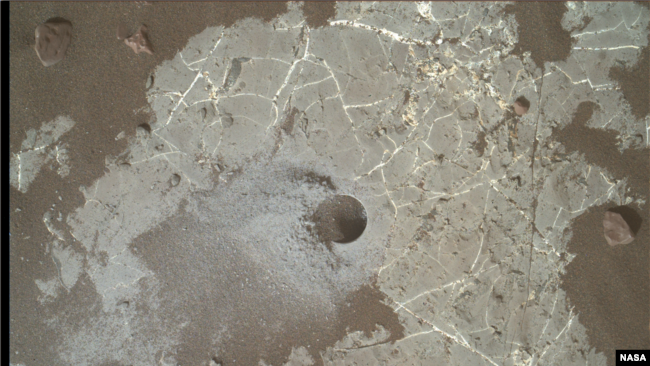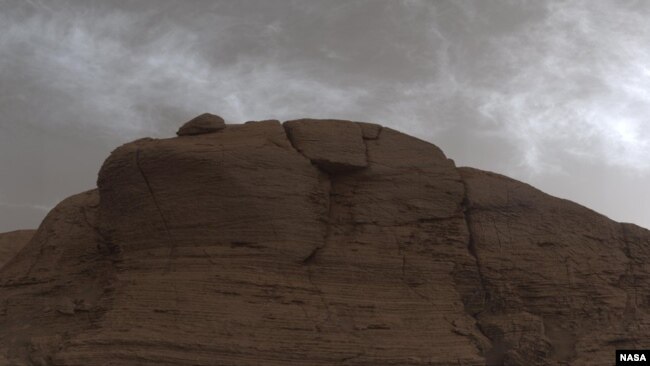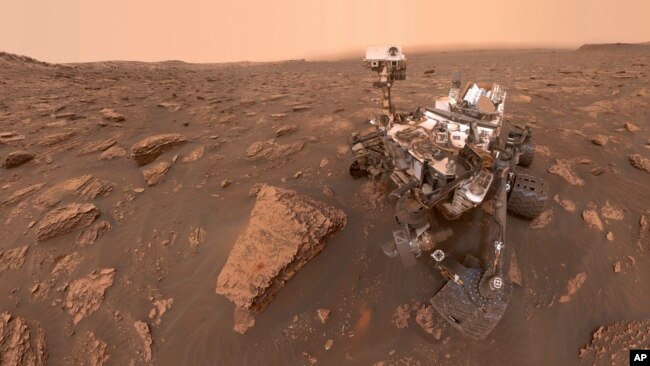火星に古代の生命の痕跡か?!
炭素の存在する12と13という2つの天然同位体測定することで、過去の炭素に関連する活動に関するシグナルを得ることができる、ってすごいですね!!
一つ一つが刺激的です!!
今ここに、地球に居ながらにして。火星の写真が見れるなんて!❣️
VOAで英語を学び、この心躍るニュースを共有しましょう!!
Here we go!!
研究成果: 火星の岩石が生命につながる炭素の’シグナル’を含んでいる可能性(和訳)
Study: Mars Rock Contains Carbon ‘Signals’ Possibly Linked to Life
January 23, 2022
火星で採取された岩石には、地球上の生物と同じ種類の炭素の”シグナル”が含まれていることが、新しい研究で明らかになりました。
科学者たちは、炭素の存在は火星に古代の生物学的生命が存在した証拠を示唆しているかもしれないと言っています。しかし、彼らはまた、この発見が非生物学的プロセスに関連している可能性があることを指摘しています。
この研究は、アメリカの宇宙機関NASAの探査機Curiosityキュリオシティが収集した岩石サンプルに基づいています。同探査機、ローバー、は2012年に火星に着陸しました。そして火星のゲール・クレーター周辺を探査してきました。
探査機はロボットアームを使い、火星の地表から岩石を採取します。このサンプルはキュリオシティの化学実験室内で高熱にさらされたとNASAは説明しています。その結果、岩石物質からガスが放出されました。
そして、探査機の機器のひとつで、加熱の過程で放出された炭素の同位体を測定しました。この実験結果は、地上の科学者によって検証されました。その結果は、米国科学アカデミー紀要(PNAS)に報告された。
炭素は、地球上のすべての生命に存在する重要な元素です。炭素には12と13という2つの天然同位体が存在します。これらの同位体を測定することで、研究者は過去の炭素に関連する活動に関するシグナルを得ることができるのです。
今回の研究では、採取した試料に炭素12が大量に含まれていることがわかりました。この種の炭素は、地球上の生物が食物や太陽からエネルギーを得るために使用されると、NASAは指摘しています。
クリストファー・ハウス氏は、ペンシルベニア州立大学を拠点とするキュリオシティの科学者です。彼がこの研究を主導しました。
ハウス氏は声明の中で、地球上では”私たちが火星で検出した炭素信号を生成するプロセスは生物学的なものである”と述べています。さらに、"火星は非常に異なっているので、同じ説明が火星でも通用するのか、あるいは、他の説明があるのかを理解しなければなりません。"と付け加えました。
生物学的な説明には、バクテリアが大気中にメタンガスを放出したという考え方があります。紫外線によって、このガスがより大きく、より複雑な分子に変換され、地表に降り積もった可能性がある。これらの分子は、キュリオシティが収集した火星の岩石の中に残っていた可能性があります。
2019年、NASAの研究者は、キュリオシティが火星の表面でメタンのレベルを測定したことを報告しました。研究チームは、これも古代の生命の兆候である可能性があると述べましたが、NASAは、このメタンが生物学的な原因から生じたものかどうかを確認することはできていません。

This image shows the Highfield drill hole made by NASA’s Mars Curiosity rover as it was collecting a rock sample on “Vera Rubin Ridge” in Gale Crater. (Photo Credit: NASA/JPL-Caltech/MSSS)この画像は、NASAの火星探査機キュリオシティがゲールクレーターのベラルービン隆起で岩石サンプルを採取する際に開けたハイフィールドドリルホールの様子。(写真提供:NASA/JPL-Caltech/MSSS)
今回の研究では、他に2つの説(いずれも非生物学的なもの)が挙げられています。
ひとつは、炭素信号が火星大気中の紫外線と炭酸ガスとの相互作用によって生じた可能性を示唆するものです。この過程で、炭素を含む分子が生成され、地表に沈降した可能性があ流のです。
もう一つの説は、炭素は何億年も前の出来事から生じたというものです。そのとき、太陽系は巨大な塵の雲を通過し、その雲には今回発見されたような炭素が豊富に含まれていた可能性があるります。
「3つの説明ともデータに合致している」とハウス氏は言います。「そのためには、より多くのデータが必要なのです。」と。

This photo, compiled from 28 images, shows the view from NASA’s Curiosity Mars rover on April 9, 2020. It shows the landscape of the Stimson sandstone formation in Gale Crater. (Photo Credit: NASA/JPL-Caltech/MSSS)この写真は、2020年4月9日にNASAの火星探査機キュリオシティから見た、28枚の画像を編集したもの。ゲールクレーターにあるスティムソン砂岩層の風景が写っている。(写真提供:NASA/JPL-Caltech/MSSS)
ワシントンD.C.のカーネギー科学研究所を拠点とするアンドリュー・スティール氏は、キュリオシティが火星表面の炭素同位体を研究するツールを搭載した最初の探査機であると指摘しています。
「火星の炭素サイクルを定義することは、そのサイクルに生命がどのように適合し得るかを理解するための絶対的な鍵です」とスティール氏は述べます。「地球上ではうまくいっていますが、火星での炭素サイクルはまだ始まったばかりです。」と彼は付け加えています。
Study: Mars Rock Contains Carbon ‘Signals’ Possibly Linked to Life
A new study has found that rock material collected on Mars contains the same kinds of carbon “signals” linked to living organisms on Earth.
Scientists say the presence of carbon may suggest evidence of ancient biological life on Mars. But they also note that the finding could be related to nonbiological processes.
The study is based on rock samples collected by the American space agency NASA’s Curiosity explorer. The explorer, or rover, landed on Mars in 2012. It has been exploring areas around the planet’s Gale Crater.
The rover used a robotic arm to collect rock material from below the surface of Mars. The samples were subjected to high heat inside a chemistry laboratory on Curiosity, NASA explained. This resulted in a release of gas from the rock material.
One of the rover’s instruments then measured isotopes from carbon released during the heating process. Results of the experiment were examined by scientists on Earth. Their findings were recently reported in a study in Proceedings of the National Academy of Sciences (PNAS).
Carbon is an important element because it is present in all life on Earth. Carbon has two naturally occurring isotopes, 12 and 13. Measuring these isotopes can provide researchers with signals about carbon-related activities from the past.
The study found that the collected samples had large amounts of carbon 12. This kind of carbon is used by living creatures on Earth to get energy from food or the sun, NASA noted.
Christopher House is a Curiosity scientist based at Pennsylvania State University. He led the study.
House said in a statement that on Earth, “processes that would produce the carbon signal we’re detecting on Mars are biological.” He added: “We have to understand whether the same explanation works for Mars, or if there are other explanations, because Mars is very different.”
The biological explanation involves the idea that bacteria may have released methane gas into the atmosphere. Ultraviolet light could have converted this gas into larger, more complex molecules that settled on the surface. These molecules could have remained in the Martian rocks collected by Curiosity.
In 2019, NASA researchers reported that Curiosity had measured levels of methane on the surface of Mars. While the team said this could also be a sign of ancient life, NASA has not been able to confirm whether the methane resulted from biological causes.
Two other theories – both nonbiological – are identified in the new study.
One explanation suggests the carbon signals might have resulted from an interaction of ultraviolet light and carbon dioxide gas in the Martian atmosphere. This process could have produced carbon-containing molecules that settled on the surface.
The other theory is that the carbon could have resulted from an event hundreds of millions of years ago. In that event, the solar system passed through a huge cloud of dust that could have been rich in the kind of carbon discovered in the rock samples.
“All three explanations fit the data,” House said. “We simply need more data to rule them in or out.
Andrew Steele is a Curiosity scientist based at the Carnegie Institution for Science in Washington D.C. He noted that Curiosity is the first rover to be equipped with the tools to study carbon isotopes on the surface of Mars.
“Defining the carbon cycle on Mars is absolutely key to trying to understand how life could fit into that cycle,” Steele said. “We have done that really successfully on Earth, but we are just beginning to define that cycle for Mars,” he added.
Words in This Story
sample – n. a small amount of something that gives you information about the thing it was taken from
isotope – n. a form of atom that has a different atomic weight from other forms of the same atom but the same chemical structure
occur – v. to happen
convert – v. to change the appearance, form or purpose of something
cycle – n. a series of events that happen in a particular order and are often repeated
absolutely – adv. completely
key – adj. very important in influencing or achieving something

